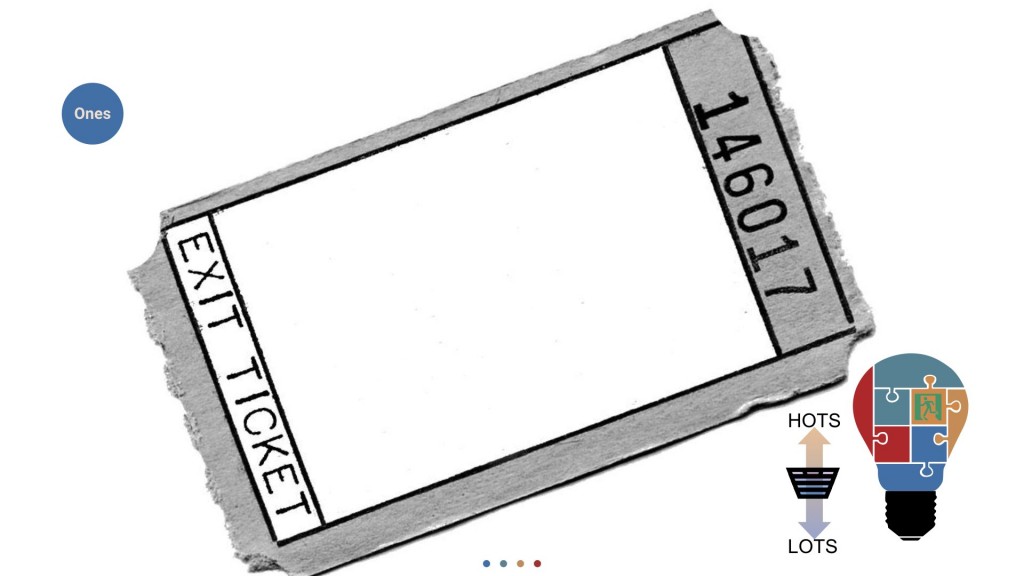PLAs #7 – Exit Ticket
As in PLA #8 – One Word, The Exit Ticket is an activity you do at the end of an activity, lesson, unit, project, presentation, midterm, or course. It’s a way to get students to critically reflect in some way that you decide, but it also pushes every individual to give you a response.
Unlike One Word, though, you allow your students to write a sentence or two, or a bullet point or two to summarise what they are learning. The Exit Ticket must be given to you before the student is allowed to leave the session, though, thus forcing responses from everyone. This isn’t necessarily a bad thing: your students need to be in constant practice of self-reflection, and writing down a reflection helps to reinforce what they have learned, especially the most salient points. The Exit Ticket can help you adjust your lessons down the road, as it’s also a good example of formative feedback coming from your students about how your lessons are going.
Take advantage of participatory learning activities like this, and use them often, requesting different types of reflections as you go.
Nearpod and Padlet have tools where you can gather individual student responses to any prompt you give them that helps them to self-reflect on what they’ve learned.
Name: Exit Ticket
Activity type: Exit
HOTS: Learners critically reflect on the events of the activity, class, presentation, project, or unit, and must distill their thinking, producing a short summary of some kind.
Grouping: Best with ONES in an entire class, but if you use it more often, try using a breakout room to have them discuss in CIRCLES so that smaller groups who worked together can peer assess before they fill out their Exit Ticket.
Online tool: Try the “open-ended question” tool or the “collaborate” tool in Nearpod. Making a Padlet produces a similar result to the “collaborate” tool in Nearpod. A discussion board in BbL could also work if you want to extend the discussion out more.
This is the Top Ten Participatory Learning Activities (PLAs) Series. Each week, Dr. Larry Davies describes PLAs that are effective to use online. Your use of these PLAs will foster better learning and higher motivation in your learners. Each PLA contains an illustration that contains four elements:
- The name of the activity.
- Which one of the four types the activity is (that’s the lightbulb), including,
- Creative/critical thinking activity (inside the lightbulb, top left – the brain);
- Small group conversational activity (bottom left – the speech bubbles);
- Exit activity (given at the end of a lesson, unit, or project) (top right – the exit sign);
- Timed activity (where learners are under pressure to complete it within minutes) (bottom left – the clock).
- Whether it’s a Higher or Lower Order Thinking Skills Activity (HOTS or LOTS) (the HOTS/LOTS lever with “the pail”).
- A suggested grouping to maximize the benefit of the activity (the circles arranged in many ways).
Also, the description will contain suggestions for one or more online tools you can use with the PLA.
Previous blogs in this series include:
Subscribe to our Newsletter
Recent Posts
Teaching infographics #2 – VOCAL: Traits of a Successful Online Teacher
This graphic is a quick guide for some common s...10 routines for teaching online – #4 Talk types
The idea of ‘talk types’ is loosely...
Differentiating Instruction in Your LMS
Anyone who has been in the world of education f...
Authors
- Andy Steele (9)
- Azim Ahmed (12)
- Christine Lampe (3)
- Gemma Escott (1)
- Larry Davies (25)
- Mahinour Ezzat (1)
- Raghad Nihlawi (16)
- Samantha McDonald Amara (16)
- Sarah Whittaker (55)
- Silishi Noushad (1)
Categories
- Adult Learning
- Assessment
- Blackboard
- Blackboard
- BookWidgets
- Collaborate Ultra
- Ed Tech
- Grade Center
- ILC
- Infographics
- Instruction
- Learning Technology Tools
- Microsoft
- Mobile OS
- Mobile Technology
- Nearpod
- News & Events
- PLAs
- Professional Development
- Routines
- Teaching with Technology
- Uncategorized
- Webinars
Tag Cloud
Archives
- February 2021
- November 2020
- October 2020
- September 2020
- August 2020
- July 2020
- June 2020
- May 2020
- April 2020
- March 2020
- February 2020
- January 2020
- December 2019
- November 2019
- October 2019
- September 2019
- August 2019
- June 2019
- May 2019
- April 2019
- March 2019
- February 2019
- March 2016
- January 2016
- November 2015
- October 2015
- June 2015
- May 2015
- March 2015
- February 2015
- January 2015
- November 2014
- October 2014
- September 2014
- August 2014
- June 2014
- May 2014
- April 2014
- March 2014
- February 2014
- January 2014
- September 2013
- January 2013
- December 2012
- November 2012
- October 2012
- July 2012
- April 2012
- March 2012

